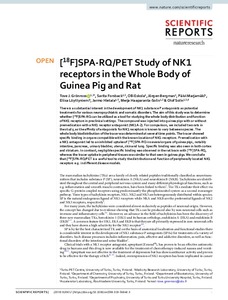[18F]SPA-RQ/PET Study of NK1 receptors in the Whole Body of Guinea Pig and Rat
Eliisa Löyttyniemi; Päivi Marjamäki; Merja Haaparanta-Solin; Jarmo Hietala; Tove J. Grönroos; Olli Eskola; Sarita Forsback; Jörgen Bergman; Olof Solin
https://urn.fi/URN:NBN:fi-fe2021042612037
Tiivistelmä
There is a substantial interest in the development of NK1 substance P antagonists as potential treatments for various neuropsychiatric and somatic disorders. The aim of this study was to determine whether [18F]SPA-RQ can be utilized as a tool for studying the whole body distribution and function of NK1 receptors in preclinical settings. The compound was injected into guinea pigs with or without premedication with a NK1 receptor antagonist (NK1A-2). For comparison, we included two rats in the study, as the affinity of antagonists for NK1 receptors is known to vary between species. The whole body biodistribution of the tracer was determined at several time points. The tracer showed specific binding in organs compatible with the known location of NK1-receptors. Premedication with a NK1 antagonist led to an inhibited uptake of [18F]SPA-RQ in several organs of guinea pigs, notably intestine, pancreas, urinary bladder, uterus, skin and lung. Specific binding was also seen in both cortex and striatum. In contrast, negligible specific binding was observed in the rat brain with [18F]SPA-RQ, whereas the tracer uptake in peripheral tissues was similar to that seen in guinea pigs. We conclude that [18F]SPA-RQ/PET is a useful tool to study the distribution and function of peripherally located NK1 receptors e.g. in different disease models.
Kokoelmat
- Rinnakkaistallenteet [19204]
